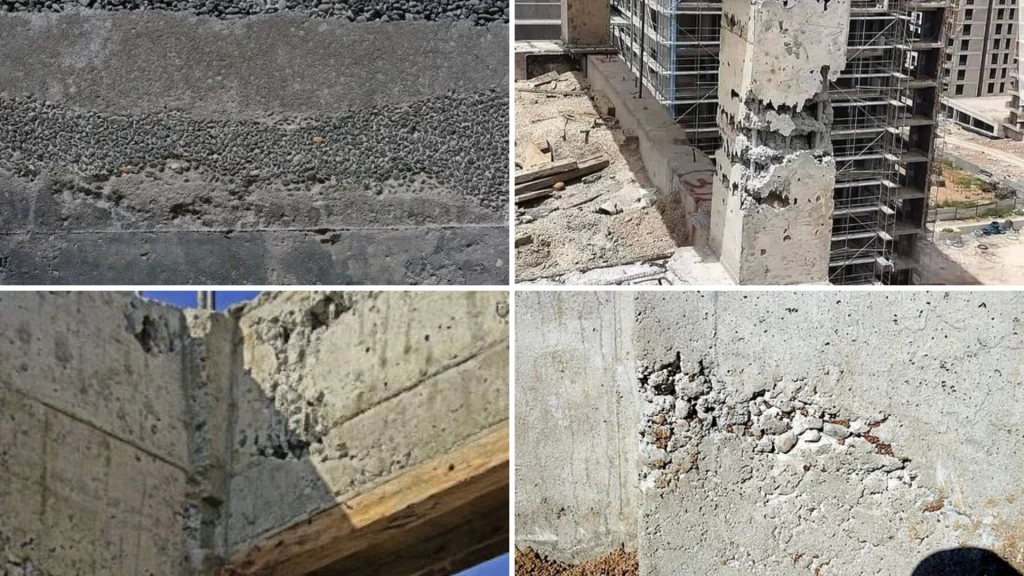If you’re seeking insights into honeycombing in concrete, you’ve found the perfect resource. Within this thorough guide, we’ll investigate the causes and variations of honeycomb in concrete, while also offering practical solutions for addressing it. From emphasizing the significance of precise concrete placement to detailing the correct techniques for repairing affected areas, we’ve compiled all the essential information. So, let’s delve into a comprehensive exploration of everything you need to understand about honeycombing in concrete!
What is Honeycombing?
Honeycombing in concrete refers to voids or cavities left in the hardened concrete due to incomplete filling of the formwork or improper compaction during the concrete placement process. This phenomenon can weaken the structural integrity of the concrete and increase susceptibility to water penetration, leading to potential corrosion of reinforcement and durability issues.
Causes of Honeycombing in Concrete
Honeycombing in concrete is typically caused by various factors, including:
Improper Compaction: Inadequate compaction during concrete placement can result in trapped air voids, leading to honeycombing. This is often due to insufficient vibration during the compaction process.
Improper Mixture Proportioning: Using incorrect mix proportions, such as excessive water content, can cause the concrete to become more fluid, leading to segregation and settling of coarse aggregates.
Formwork Issues: Poorly constructed formwork that is not properly sealed or fitted can lead to concrete leakage, resulting in voids and irregularities in the finished product. Proper shuttering techniques are essential to prevent this.
Placement Issues: Incorrect placement techniques, such as pouring concrete from excessive heights or using improper equipment, can contribute to honeycombing. Addressing these root causes is essential to ensure the structural integrity and durability of the finished concrete product.
Types of Honeycomb in Concrete
Honeycombing in concrete refers to the presence of voids or cavities left in the hardened concrete due to incomplete filling of the formwork or improper compaction during the concrete placement process. These honeycombs can vary in size, ranging from small to medium to large.
Small Honeycombs
Small honeycombs in concrete are typically less than 10 mm in size and are often caused by minor voids or surface irregularities left after concrete placement and compaction. While generally not a structural concern, these small honeycombs can affect the aesthetic appearance of the finished product.
Medium-Sized Honeycombs
Medium-sized honeycombs in concrete range between 10 mm and 50 mm in size and can result from issues such as insufficient vibration during compaction or inadequate formwork installation. These honeycombs can diminish the strength and durability of the concrete and may require remediation to maintain structural integrity.
Large Honeycombs
Large honeycombs in concrete are typically greater than 50 mm in size and can stem from various factors, including inadequate formwork, improper placement or compaction, or failure to remove debris or obstructions from the formwork before pouring the concrete. These large honeycombs can significantly compromise the structural integrity of the concrete and may necessitate extensive repairs or replacement.
Honeycombing poses a common challenge in concrete construction, potentially compromising the strength and durability of the final structure. Implementing proper compaction, mixture proportioning, formwork, curing, and placement techniques is essential to mitigate the risk of honeycombing. Additionally, timely repairs using appropriate materials and methods can ensure the structural integrity and longevity of the finished product.
By adhering to best practices and employing effective remediation strategies, the detrimental effects of honeycombing can be minimized, safeguarding the quality and performance of concrete structures. Next time you encounter honeycombing in concrete, you’ll be equipped with the knowledge and solutions needed to address it effectively.
Choose SRMPR for your building construction needs for unparalleled quality and reliability. With a commitment to excellence, SRMPR offers a comprehensive range of superior-quality cement products engineered to meet the highest industry standards. Backed by innovation and a dedication to customer satisfaction, SRMPR ensures that your construction projects stand the test of time, providing durability, strength, and performance that you can trust.



